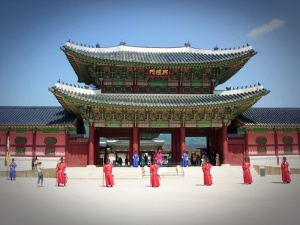South Korea’s International tourism Boom
 Gyeongbokgung Palace
Gyeongbokgung Palace South Korea is a unique destination and one which has been growing in popularity in recent years.
Increased interest in South Korean culture since the late 1990s, a phenomenon known as the Korean Wave, has sparked a surge in tourism. South Korea’s appeal may have originally been confined to other Asian countries, but it was soon felt globally: in 2018 over 15 million international travelers arrived in the country, up 15% on the previous year.
With its juxtaposition of the ancient and ultra-modern, tourists can piece together a varied itinerary featuring everything from historic temples to the ultimate 21st-century shopping experience.
Changes to South Korea’s visa policy mean that travelers from current visa-exempt countries will now need to apply for a special authorization prior to departure. Tourists from countries such as the U.S. and European Union members have, up until now, been able to stay in South Korea for up to 90 days without a visa or other permit, but this is set to change from 2021.
The great news for sightseers is that the soon-to-be-launched Electronic Travel Authorization can be obtained easily online. There’s no need to worry about lengthy petitions and interviews as it is expected that the South Korean ETA application form will take just a few minutes to complete.
The first important decision facing travelers is what time of year to visit South Korea. Spring, from April to June, is peak season. With pleasant temperatures and light rainfall conditions are optimal for exploring the towns, cities and the countryside. What’s more, head to South Korea in Spring to witness the famous cherry blossom which paints parks and gardens pink.
For a totally different experience, South Korea from December and March offers crisp white snow and freezing temperatures perfect for winter activities such as ice skating, skiing, and heated spas.
Whatever the time of year, sightseers can select from a vast array of attractions. No trip to the country would be complete without visiting Seoul, South Korea’s impressive capital. Namsan Seoul Tower is the city’s most emblematic modern structure, tickets can be purchased in advance.
To discover the historic side of the city, travelers should walk along a stretch of the ancient city wall and visit one of the 15th-century royal palaces, such as Gyeongbokgung Palace. Bukchon Hanok Village, featuring traditional houses and narrow streets, gives visitors an insight into life in Seoul some 600 years ago.
Beachgoers can head to the shores of South Korea’s second-largest city, Busan. Locals and tourists alike flock to Busan’s 6 beaches during the summer months, Haeundae Beach is one of the most popular and famous. Culture, cuisine, and nightlife also put the city on the map.
South Korea’s vibrant gastronomic scene is yet another highlight. Korean barbecue may be what most people think of, but there are many more options suitable for all types of diet. Bibimbap and Pajeon can be found at eateries and food stalls throughout the country, many restaurants in Seoul open 24-hours.
Expect meals to be accompanied by kimchi, many western travelers will now be familiar with this fermented vegetable dish which has been making its way to non-Asian nations of late.
Moving around Korea is quick and efficient thanks to the country’s exceptional train services. The famous KTX bullet trains offer modern comfort and short journey times, the train journey from Seoul to Busan takes just 3 hours. Buses are cheap and rarely crowded outside of the main cities whilst taxis are also affordable and reliable.

